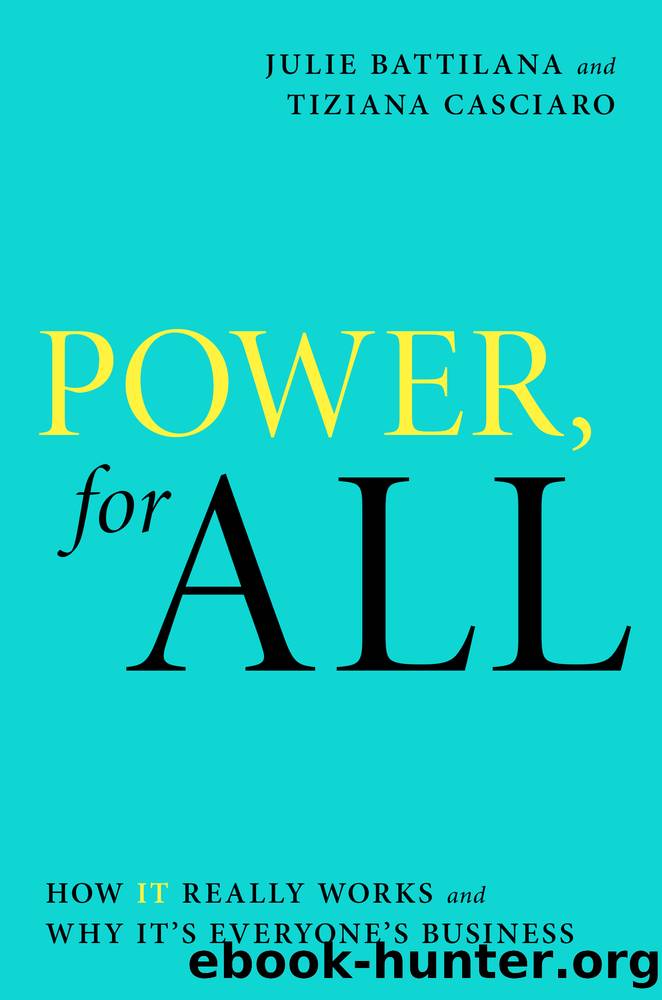Power, for All: How It Really Works and Why It's Everyone's Business by Julie Battilana & Tiziana Casciaro

Author:Julie Battilana & Tiziana Casciaro [Battilana, Julie & Casciaro, Tiziana]
Language: eng
Format: epub
Tags: Business & Economics, Leadership, Self-Help, Personal Growth, Success, Motivational
ISBN: 9781982141653
Google: 8fkDEAAAQBAJ
Publisher: Simon and Schuster
Published: 2021-08-31T23:19:38.261953+00:00
HOW THE DIGITAL REVOLUTION SHUFFLED THE CARDS
One of the earliest traces of an algorithm was found in Iraq, inscribed on a Sumerian clay tablet dating back to around 2500 BCE. It consisted of a set of instructions for the task of division.16 At its root, an âalgorithmâ is just another word for a set of directions.17 Algorithms have evolved a great deal since their early appearance, and today, the word is most commonly used to refer to âa sequence of instructions telling a computer what to do.â18 These instructions can be input by humans. For instance, a coder might write an algorithm telling the computer to generate the shortest walking route between point A and point B. But in the era of big data enabled by the digital revolution, computers can be made to write their own instructions based on large sets of data inputs and outputs provided by the coders. For example, if the coder feeds the computer a list of divisions, without the computer knowing what division is, the machine will spot the pattern and learn to replicate it on its own. This is what people mean by âmachine learning,â an application of artificial intelligence (AI) that has tremendously accelerated our ability to process and learn from massive amounts of data, and to optimize and increase the efficiency, precision, and predictive accuracy of machines.19
Digital technology is producing astounding progress, improving our lives in countless ways. Coupled with big data, machine-learning algorithms can learn from thousands of medical images to recognize a cancerous mass in human tissue earlier and more accurately than the human eye can.20 Mobile health technology is improving and reducing the cost of transmitting health-care information, delivering patient care, and monitoring medication adherence, with the potential to democratize access to health solutions in rural areas in low- and middle-income countries worldwide.21 And technologyâs benefits go well beyond medicine. With the aid of its innovative tools and processes, we are improving the productivity of natural resources and sources of energy, the safety and performance of motor vehicles and industrial materials, the availability and affordability of information and consumer goods, and myriad other conveniences and opportunities to satisfy our need for safety and self-esteem.
Algorithmic decision-making is improving our lives in large part because it uses vastly greater amounts of data than humans can process, and it is consistent, precise, and reliable in ways that people arenât. As a result, it has the potential to benefit people whom human decision makers, consciously or unconsciously, discriminate against. For example, a study of automated loan underwriting showed that it can be more accurate than human underwriting in predicting defaults, resulting in a higher rate of approved loans, especially for underserved customers.22
Alongside this progress and potential for empowerment, however, digital technology and AI have also affected two critical aspects of the distribution of power that require our vigilance and oversight: the control of algorithms and the control of personal information.
First, control of algorithms is critical because they can be biased, and when
Download
This site does not store any files on its server. We only index and link to content provided by other sites. Please contact the content providers to delete copyright contents if any and email us, we'll remove relevant links or contents immediately.
Zero to IPO: Over $1 Trillion of Actionable Advice from the World's Most Successful Entrepreneurs by Frederic Kerrest(4195)
Machine Learning at Scale with H2O by Gregory Keys | David Whiting(3984)
Harry Potter and the Goblet Of Fire by J.K. Rowling(3746)
Never by Ken Follett(3715)
Ogilvy on Advertising by David Ogilvy(3464)
Shadow of Night by Deborah Harkness(3268)
The Man Who Died Twice by Richard Osman(2963)
Book of Life by Deborah Harkness(2841)
My Brilliant Friend by Elena Ferrante(2745)
Will by Will Smith(2745)
0041152001443424520 .pdf by Unknown(2734)
How Proust Can Change Your Life by Alain De Botton(2696)
The Tipping Point by Malcolm Gladwell(2627)
Purple Hibiscus by Chimamanda Ngozi Adichie(2591)
How to Pay Zero Taxes, 2018 by Jeff A. Schnepper(2564)
Hooked: A Dark, Contemporary Romance (Never After Series) by Emily McIntire(2470)
Rationality by Steven Pinker(2235)
Borders by unknow(2155)
Daughter of Smoke and Bone by Laini Taylor(2123)
